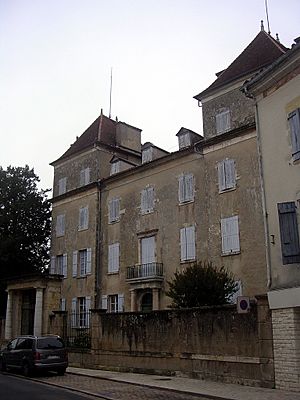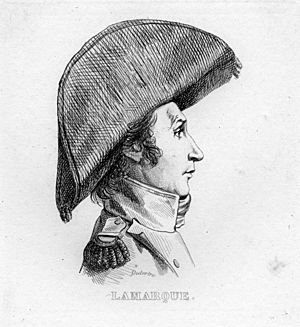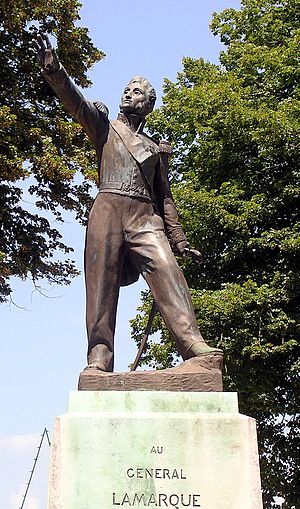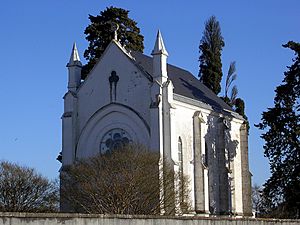Jean Maximilien Lamarque facts for kids
Quick facts for kids
Jean Maximilien Lamarque
|
|
|---|---|
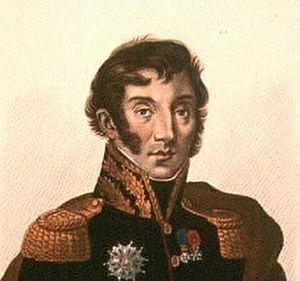
Jean Maximilien Lamarque
|
|
| Born | 22 July 1770 Saint-Sever, Landes |
| Died | 1 June 1832 (aged 61) Paris, France |
| Allegiance |
|
| Years of service | 1791–1830 |
| Rank | General of Division |
| Battles/wars | French Revolutionary Wars; Napoleonic Wars |
| Awards | Royal Order of the Two-Sicilies Légion d'honneur |
| Other work | Politician; Writer |
Jean Maximilien Lamarque (born July 22, 1770 – died June 1, 1832) was a brave French general during the Napoleonic Wars. After his military career, he became a member of the French Parliament. Lamarque was known for his courage and skill in many of Napoleon's battles.
He was especially famous for capturing the island of Capri from the British. He also defeated forces loyal to the old royal family in a region called Vendée in 1815. Napoleon himself praised Lamarque, saying he "performed wonders" and "even surpassed my hopes."
After the royal family returned to power, Lamarque spoke out against the old ways of governing. When the king was overthrown in the July Revolution of 1830, Lamarque was put in charge of stopping any uprisings by the king's supporters.
However, he soon became a critic of the new king, Louis Philippe I. Lamarque believed the new government did not protect human rights or political freedom enough. He also wanted France to support revolutionary movements in countries like Poland and Italy. His ideas made him very popular with the people.
When Lamarque died, it sparked a big uprising in Paris in June 1832. This event is a key part of Victor Hugo's famous novel, Les Misérables.
Contents
Early Life and Joining the Army
Jean Maximilien Lamarque was born in Saint-Sever, a town in France. His family was important and had a lot of influence. His father was a lawyer and a local official. Lamarque's father was also chosen to be a member of the French assembly in 1789, which was a big step towards the French Revolution.
Lamarque joined his father in Paris and then joined the army in 1791. He was involved in the early revolutionary activities. In 1793, he was part of a volunteer battalion.
Fighting in the Revolutionary Wars
Lamarque quickly rose through the ranks. He became a lieutenant in April 1793 and a captain by May. He fought bravely in the Army of the Western Pyrenees. In July 1794, he showed great skill by capturing the town of Hondarribia with a small group of soldiers, even though it was defended by many more men.
After this success, he was moved to the Army of the Rhine. He fought well in several important battles, including the Battle of Engen and the Battle of Hohenlinden in 1800. His performance at Hohenlinden was so impressive that General Moreau recommended him to Napoleon, who then made him a brigadier general.
Lamarque's Role in the Napoleonic Wars
When Napoleon became the leader of France, Lamarque continued to serve in the French army. He fought in the famous Battle of Austerlitz. Later, he went to Italy to help Joseph Bonaparte, Napoleon's brother.
In 1807, Joseph Bonaparte made Lamarque his Chief of Staff, which is a very important leadership position. Lamarque was then sent to capture the island of Capri from the British. He surprised the British with a daring attack and, after a tough fight, successfully took the island.
Lamarque also fought in the Battle of Wagram in 1809, where he was part of Napoleon's main army. He was so brave that four horses were shot from under him during the battle! In 1810, Napoleon made him a baron, a special title of honor. He was then sent to Spain to help Joseph Bonaparte, who was struggling as king there.
When Napoleon was sent away to the island of Elba in 1814, Lamarque remained loyal. He rejoined Napoleon during the "Hundred Days," when Napoleon briefly returned to power. While Napoleon fought in Belgium, Lamarque led a force of ten thousand men against a royalist uprising in La Vendée. He defeated the rebellion at the Battle of Rocheserviere. Even though Napoleon lost at the Battle of Waterloo, he still praised Lamarque's amazing efforts.
Life After the Wars and Political Views
After Napoleon's final defeat at Waterloo, Lamarque also went into exile for a short time. He returned to France in 1818 and became active in politics, supporting liberal ideas. He used his own money to buy land and modern farming equipment to improve agriculture in his home region of Landes. He strongly believed in making smart investments to help the economy grow.
In 1828, he was elected to the French Parliament. There, Lamarque became a popular voice for those who opposed the old royal family and their supporters.
After the July Revolution of 1830, Lamarque was put in charge of military forces to stop any uprisings against the new king, Louis-Philippe. He was also given the Legion of Honor, a very high award. He continued to support freedom and rights, writing about his ideas. He was also known for speaking out against Russia's attempts to limit the freedom of Poland. Lamarque's support for freedom in Poland and Italy was very popular in France.
Lamarque's Death and the June Rebellion
In 1832, Lamarque became sick with cholera, a disease that was spreading in France at the time. He died on June 1. Because Lamarque was a popular hero and supported the idea of a republic, his death caused riots in Paris.
On June 5, a large crowd followed his funeral procession. As it moved through the streets, people began shouting "down with Louis-Philippe, long live the Republic!" A group of students took control of the carriage carrying his coffin. The procession changed direction and went to the Place de la Bastille, where speeches were made calling for a republic. When someone waved a red flag with "Liberty or Death" written on it, the crowd broke into a rebellion, and shots were fired between the people and government soldiers.
This uprising, which happened on June 5–6, is known as the June Rebellion. It was put down by the French Army and National Guard. About 800 people were killed or wounded. While Lamarque's funeral was the spark, historians believe his death was just an excuse for people who were already unhappy with the government. The rebellion was short and only happened in Paris.
Lamarque in Les Misérables
Victor Hugo's famous novel Les Misérables tells a fictional story about the uprising that happened after General Lamarque's death. In the book, Hugo shows Lamarque as a government leader who cared about the poor. Hugo wrote that Lamarque was "loved by the people because he accepted the chances the future offered, loved by the mob because he served the emperor well."
In the novel, just like in real life, the uprising fails. However, it is shown in a very dramatic and emotional way in the book and its many adaptations for movies, radio, and stage plays.
Lamarque's Writings
During his time in exile, Lamarque spent time writing. He translated old Scottish poems called the poems of Ossian into French. He also wrote a defense of his own actions as a general.
Lamarque also wrote about his ideas for improving farming. He published a paper in 1825 about the benefits of building a canal to connect two rivers, the Garonne and l'Adour. He believed this would bring long-term economic benefits to the country.
He also wrote about his military career and political thoughts. His family later published his memoirs, which are like his autobiography, in 1835.
See also
 In Spanish: Jean Maximilien Lamarque para niños
In Spanish: Jean Maximilien Lamarque para niños
- List of French generals of the Revolutionary and Napoleonic Wars


